Improving Customer Service in Hospitality: Case Study of The Frog
VerifiedAdded on 2023/06/17
|12
|3889
|483
Report
AI Summary
This report provides an in-depth analysis of customer service management within the hospitality industry, focusing on a case study of The Frog by Adam Handling restaurant in London. The report examines factors that limit customer service, such as service and food quality, location, and atmosphere, referencing a customer review detailing issues with responsiveness, hygiene, and pricing. It also explores different customer behaviors and expectations, including personalization, quality service, quick complaint resolution, and clear communication, suggesting strategies for matching service delivery to these expectations. Furthermore, the report discusses the benefits and opportunities of exceeding customer expectations, such as differentiating from competitors and enhancing brand image. The document concludes with recommendations for improvement and highlights the importance of customer feedback and transparent communication. Desklib is mentioned as a platform offering past papers and solved assignments for students.
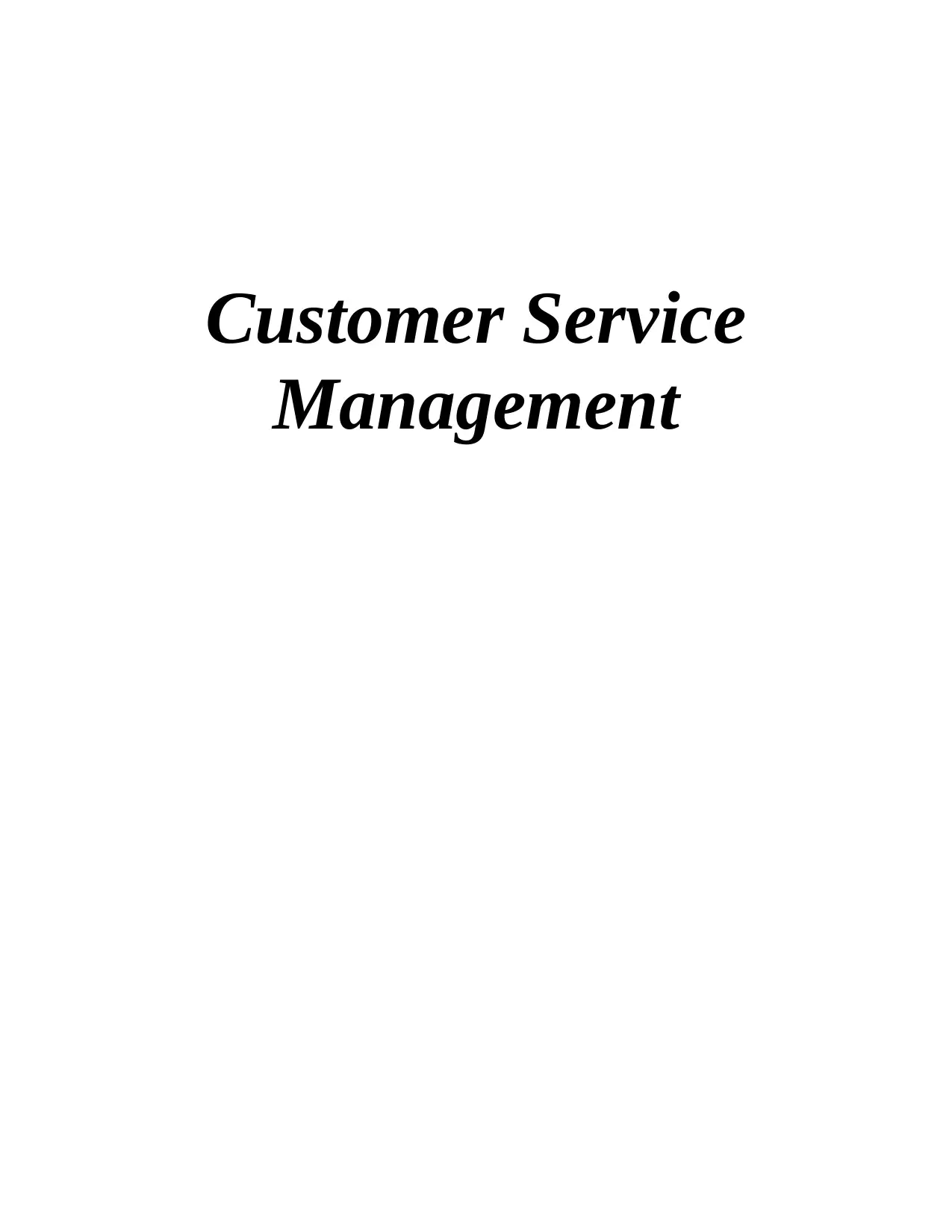
Customer Service
Management
Management
Paraphrase This Document
Need a fresh take? Get an instant paraphrase of this document with our AI Paraphraser
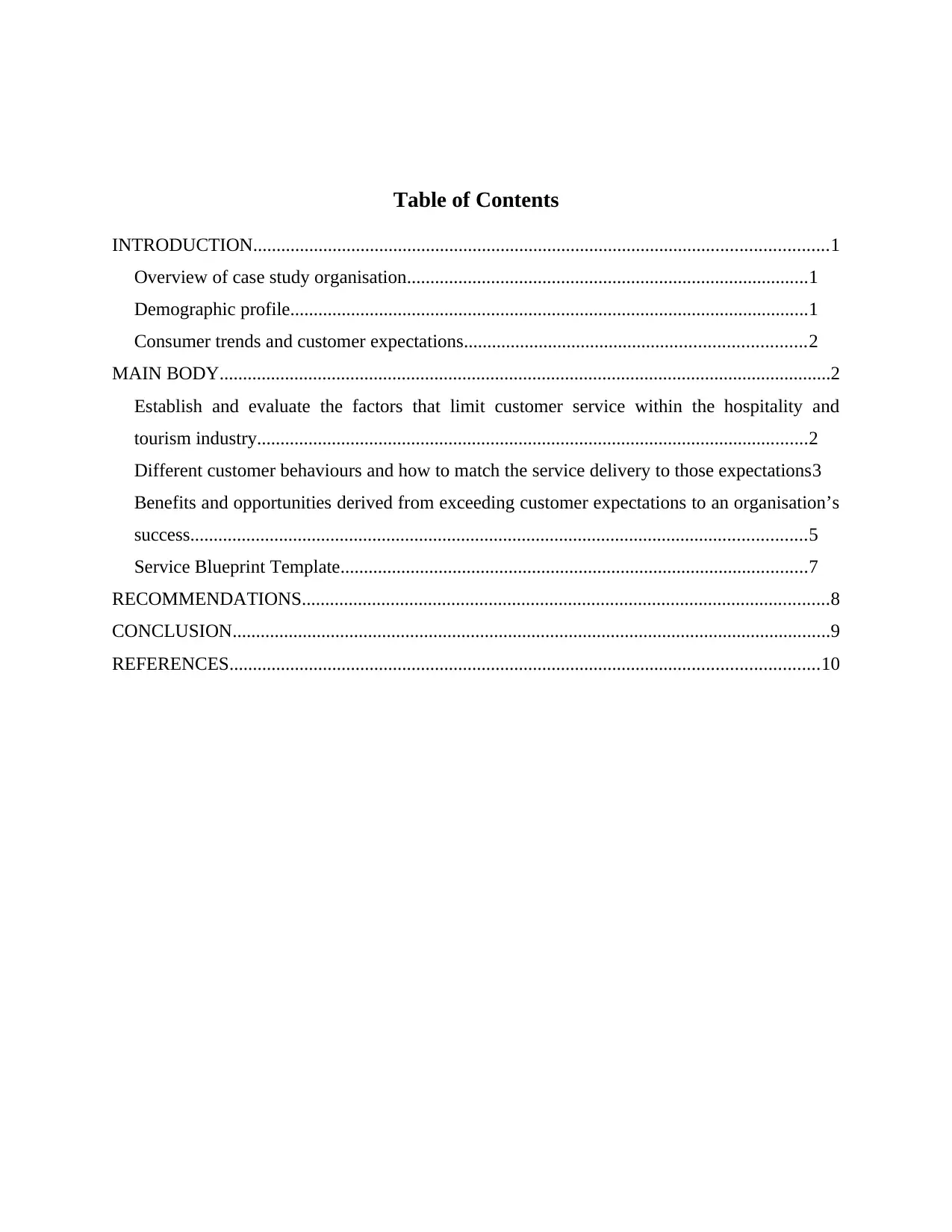
Table of Contents
INTRODUCTION...........................................................................................................................1
Overview of case study organisation......................................................................................1
Demographic profile...............................................................................................................1
Consumer trends and customer expectations.........................................................................2
MAIN BODY...................................................................................................................................2
Establish and evaluate the factors that limit customer service within the hospitality and
tourism industry......................................................................................................................2
Different customer behaviours and how to match the service delivery to those expectations3
Benefits and opportunities derived from exceeding customer expectations to an organisation’s
success....................................................................................................................................5
Service Blueprint Template....................................................................................................7
RECOMMENDATIONS.................................................................................................................8
CONCLUSION................................................................................................................................9
REFERENCES..............................................................................................................................10
INTRODUCTION...........................................................................................................................1
Overview of case study organisation......................................................................................1
Demographic profile...............................................................................................................1
Consumer trends and customer expectations.........................................................................2
MAIN BODY...................................................................................................................................2
Establish and evaluate the factors that limit customer service within the hospitality and
tourism industry......................................................................................................................2
Different customer behaviours and how to match the service delivery to those expectations3
Benefits and opportunities derived from exceeding customer expectations to an organisation’s
success....................................................................................................................................5
Service Blueprint Template....................................................................................................7
RECOMMENDATIONS.................................................................................................................8
CONCLUSION................................................................................................................................9
REFERENCES..............................................................................................................................10

INTRODUCTION
Overview of case study organisation
Customer service management is described as the strategies, practices and technologies
that various organisation utilize to organise and evaluate consumer interactions and data. This
customer life-cycle of their preferences is examined in order to improve relationship with them
and to provide them better services in future. Hospitality industry is a sector which directly
interacts with customers by providing them services such as event planning, hotels, restaurants,
travel, food services and many more (Dotzel and Shankar, 2019). The Frog by Adam Handling
located in London is also one of the restaurant which belongs to this hospitality sector. The case
study is about a restaurant called The Frog by Adam Handling which shows a review from
former customer on a travel site Tripadvisor in which the person shares their experience there.
The person shared that the services offered by restaurant was very poor as they have to ask for
the food menu and the prices of various dishes were too high. It was also mentioned in the
review that hygiene factor was missing as the toilets of restaurant were very dirty. And the
customer got ill after eating the food of restaurant and according to them it was a case of profit
over comfort. At the end customer shares that the concept of the restaurant was nice but they did
not like the services deliver to them and according to them the price of food was too expensive.
Demographic profile
Demographic profile is utilized by marketers to make themselves efficient in advertising
their products or services and also helps them in evaluating any possible gaps in their strategies
of marketing. Demographic data is very important for companies to understand how to approach
customers and plan strategically for upcoming trends according to consumer demands (Bove and
Benoit, 2020). The Frog by Adam Handling restaurant was opened in the year 2017 in London
by Adam who is a well-known chef in UK. This restaurant is a flagship for Adam Handling
Restaurant Group which is located in the heart of Covent Garden. The restaurant has also
possessed perfect location where people can host several events such as corporate gatherings,
birthdays and many more. For people who want to host private parties, the restaurant offers an
exclusive private dining room 'The Library' which has seating for 16 persons. People who want
to enjoy bar services, the restaurant has bar called 'Eve' which is under the flagship of this
restaurant and is basement serving bar.
1
Overview of case study organisation
Customer service management is described as the strategies, practices and technologies
that various organisation utilize to organise and evaluate consumer interactions and data. This
customer life-cycle of their preferences is examined in order to improve relationship with them
and to provide them better services in future. Hospitality industry is a sector which directly
interacts with customers by providing them services such as event planning, hotels, restaurants,
travel, food services and many more (Dotzel and Shankar, 2019). The Frog by Adam Handling
located in London is also one of the restaurant which belongs to this hospitality sector. The case
study is about a restaurant called The Frog by Adam Handling which shows a review from
former customer on a travel site Tripadvisor in which the person shares their experience there.
The person shared that the services offered by restaurant was very poor as they have to ask for
the food menu and the prices of various dishes were too high. It was also mentioned in the
review that hygiene factor was missing as the toilets of restaurant were very dirty. And the
customer got ill after eating the food of restaurant and according to them it was a case of profit
over comfort. At the end customer shares that the concept of the restaurant was nice but they did
not like the services deliver to them and according to them the price of food was too expensive.
Demographic profile
Demographic profile is utilized by marketers to make themselves efficient in advertising
their products or services and also helps them in evaluating any possible gaps in their strategies
of marketing. Demographic data is very important for companies to understand how to approach
customers and plan strategically for upcoming trends according to consumer demands (Bove and
Benoit, 2020). The Frog by Adam Handling restaurant was opened in the year 2017 in London
by Adam who is a well-known chef in UK. This restaurant is a flagship for Adam Handling
Restaurant Group which is located in the heart of Covent Garden. The restaurant has also
possessed perfect location where people can host several events such as corporate gatherings,
birthdays and many more. For people who want to host private parties, the restaurant offers an
exclusive private dining room 'The Library' which has seating for 16 persons. People who want
to enjoy bar services, the restaurant has bar called 'Eve' which is under the flagship of this
restaurant and is basement serving bar.
1
⊘ This is a preview!⊘
Do you want full access?
Subscribe today to unlock all pages.

Trusted by 1+ million students worldwide
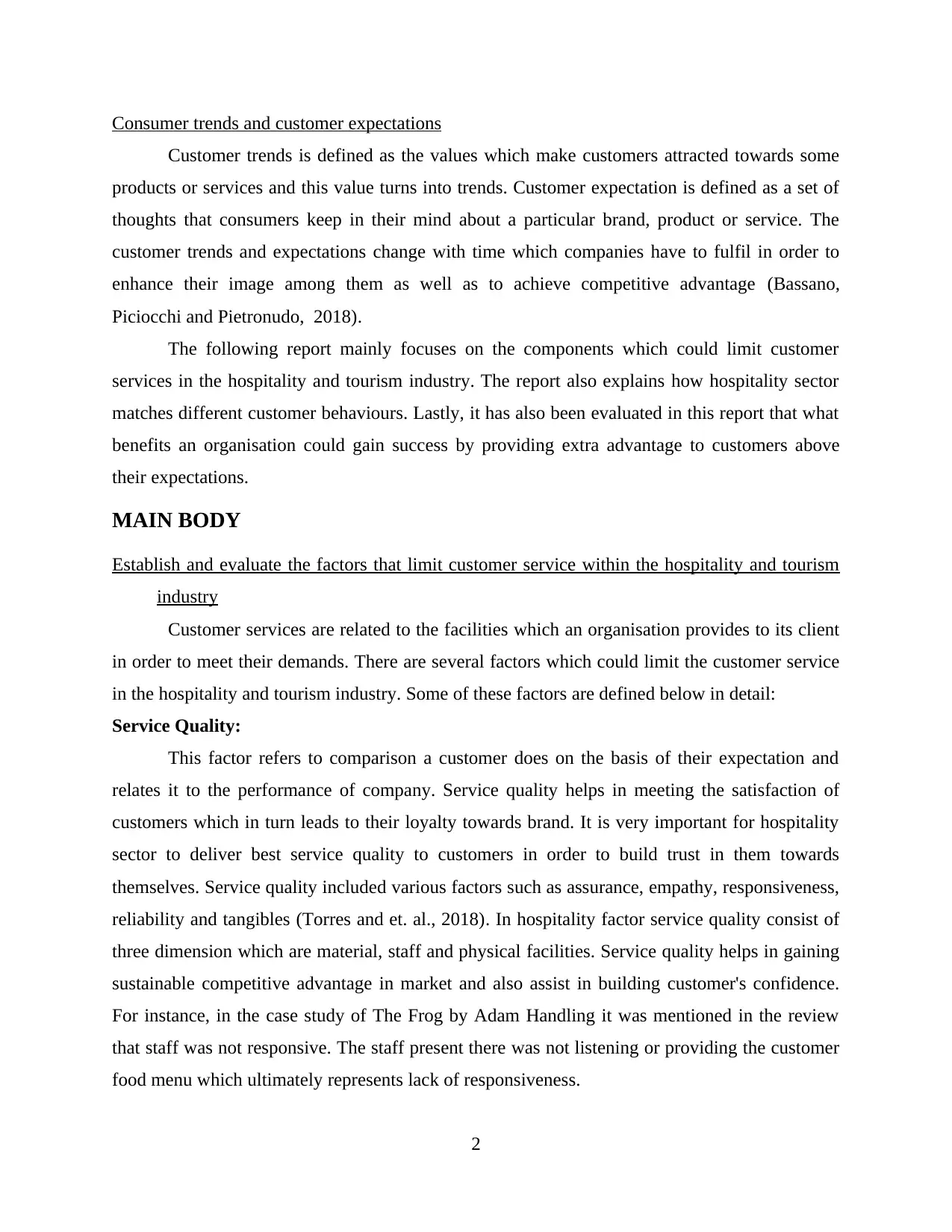
Consumer trends and customer expectations
Customer trends is defined as the values which make customers attracted towards some
products or services and this value turns into trends. Customer expectation is defined as a set of
thoughts that consumers keep in their mind about a particular brand, product or service. The
customer trends and expectations change with time which companies have to fulfil in order to
enhance their image among them as well as to achieve competitive advantage (Bassano,
Piciocchi and Pietronudo, 2018).
The following report mainly focuses on the components which could limit customer
services in the hospitality and tourism industry. The report also explains how hospitality sector
matches different customer behaviours. Lastly, it has also been evaluated in this report that what
benefits an organisation could gain success by providing extra advantage to customers above
their expectations.
MAIN BODY
Establish and evaluate the factors that limit customer service within the hospitality and tourism
industry
Customer services are related to the facilities which an organisation provides to its client
in order to meet their demands. There are several factors which could limit the customer service
in the hospitality and tourism industry. Some of these factors are defined below in detail:
Service Quality:
This factor refers to comparison a customer does on the basis of their expectation and
relates it to the performance of company. Service quality helps in meeting the satisfaction of
customers which in turn leads to their loyalty towards brand. It is very important for hospitality
sector to deliver best service quality to customers in order to build trust in them towards
themselves. Service quality included various factors such as assurance, empathy, responsiveness,
reliability and tangibles (Torres and et. al., 2018). In hospitality factor service quality consist of
three dimension which are material, staff and physical facilities. Service quality helps in gaining
sustainable competitive advantage in market and also assist in building customer's confidence.
For instance, in the case study of The Frog by Adam Handling it was mentioned in the review
that staff was not responsive. The staff present there was not listening or providing the customer
food menu which ultimately represents lack of responsiveness.
2
Customer trends is defined as the values which make customers attracted towards some
products or services and this value turns into trends. Customer expectation is defined as a set of
thoughts that consumers keep in their mind about a particular brand, product or service. The
customer trends and expectations change with time which companies have to fulfil in order to
enhance their image among them as well as to achieve competitive advantage (Bassano,
Piciocchi and Pietronudo, 2018).
The following report mainly focuses on the components which could limit customer
services in the hospitality and tourism industry. The report also explains how hospitality sector
matches different customer behaviours. Lastly, it has also been evaluated in this report that what
benefits an organisation could gain success by providing extra advantage to customers above
their expectations.
MAIN BODY
Establish and evaluate the factors that limit customer service within the hospitality and tourism
industry
Customer services are related to the facilities which an organisation provides to its client
in order to meet their demands. There are several factors which could limit the customer service
in the hospitality and tourism industry. Some of these factors are defined below in detail:
Service Quality:
This factor refers to comparison a customer does on the basis of their expectation and
relates it to the performance of company. Service quality helps in meeting the satisfaction of
customers which in turn leads to their loyalty towards brand. It is very important for hospitality
sector to deliver best service quality to customers in order to build trust in them towards
themselves. Service quality included various factors such as assurance, empathy, responsiveness,
reliability and tangibles (Torres and et. al., 2018). In hospitality factor service quality consist of
three dimension which are material, staff and physical facilities. Service quality helps in gaining
sustainable competitive advantage in market and also assist in building customer's confidence.
For instance, in the case study of The Frog by Adam Handling it was mentioned in the review
that staff was not responsive. The staff present there was not listening or providing the customer
food menu which ultimately represents lack of responsiveness.
2
Paraphrase This Document
Need a fresh take? Get an instant paraphrase of this document with our AI Paraphraser
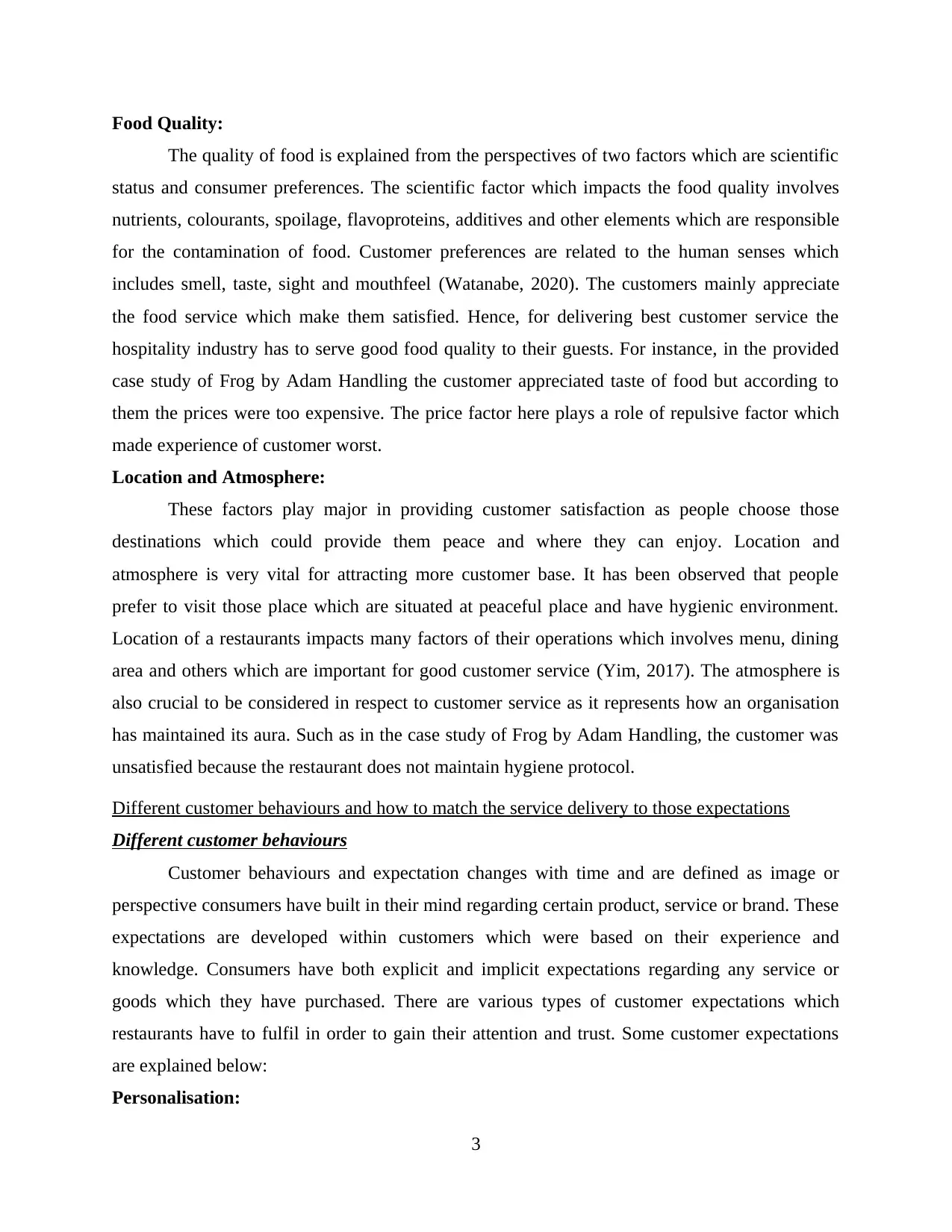
Food Quality:
The quality of food is explained from the perspectives of two factors which are scientific
status and consumer preferences. The scientific factor which impacts the food quality involves
nutrients, colourants, spoilage, flavoproteins, additives and other elements which are responsible
for the contamination of food. Customer preferences are related to the human senses which
includes smell, taste, sight and mouthfeel (Watanabe, 2020). The customers mainly appreciate
the food service which make them satisfied. Hence, for delivering best customer service the
hospitality industry has to serve good food quality to their guests. For instance, in the provided
case study of Frog by Adam Handling the customer appreciated taste of food but according to
them the prices were too expensive. The price factor here plays a role of repulsive factor which
made experience of customer worst.
Location and Atmosphere:
These factors play major in providing customer satisfaction as people choose those
destinations which could provide them peace and where they can enjoy. Location and
atmosphere is very vital for attracting more customer base. It has been observed that people
prefer to visit those place which are situated at peaceful place and have hygienic environment.
Location of a restaurants impacts many factors of their operations which involves menu, dining
area and others which are important for good customer service (Yim, 2017). The atmosphere is
also crucial to be considered in respect to customer service as it represents how an organisation
has maintained its aura. Such as in the case study of Frog by Adam Handling, the customer was
unsatisfied because the restaurant does not maintain hygiene protocol.
Different customer behaviours and how to match the service delivery to those expectations
Different customer behaviours
Customer behaviours and expectation changes with time and are defined as image or
perspective consumers have built in their mind regarding certain product, service or brand. These
expectations are developed within customers which were based on their experience and
knowledge. Consumers have both explicit and implicit expectations regarding any service or
goods which they have purchased. There are various types of customer expectations which
restaurants have to fulfil in order to gain their attention and trust. Some customer expectations
are explained below:
Personalisation:
3
The quality of food is explained from the perspectives of two factors which are scientific
status and consumer preferences. The scientific factor which impacts the food quality involves
nutrients, colourants, spoilage, flavoproteins, additives and other elements which are responsible
for the contamination of food. Customer preferences are related to the human senses which
includes smell, taste, sight and mouthfeel (Watanabe, 2020). The customers mainly appreciate
the food service which make them satisfied. Hence, for delivering best customer service the
hospitality industry has to serve good food quality to their guests. For instance, in the provided
case study of Frog by Adam Handling the customer appreciated taste of food but according to
them the prices were too expensive. The price factor here plays a role of repulsive factor which
made experience of customer worst.
Location and Atmosphere:
These factors play major in providing customer satisfaction as people choose those
destinations which could provide them peace and where they can enjoy. Location and
atmosphere is very vital for attracting more customer base. It has been observed that people
prefer to visit those place which are situated at peaceful place and have hygienic environment.
Location of a restaurants impacts many factors of their operations which involves menu, dining
area and others which are important for good customer service (Yim, 2017). The atmosphere is
also crucial to be considered in respect to customer service as it represents how an organisation
has maintained its aura. Such as in the case study of Frog by Adam Handling, the customer was
unsatisfied because the restaurant does not maintain hygiene protocol.
Different customer behaviours and how to match the service delivery to those expectations
Different customer behaviours
Customer behaviours and expectation changes with time and are defined as image or
perspective consumers have built in their mind regarding certain product, service or brand. These
expectations are developed within customers which were based on their experience and
knowledge. Consumers have both explicit and implicit expectations regarding any service or
goods which they have purchased. There are various types of customer expectations which
restaurants have to fulfil in order to gain their attention and trust. Some customer expectations
are explained below:
Personalisation:
3
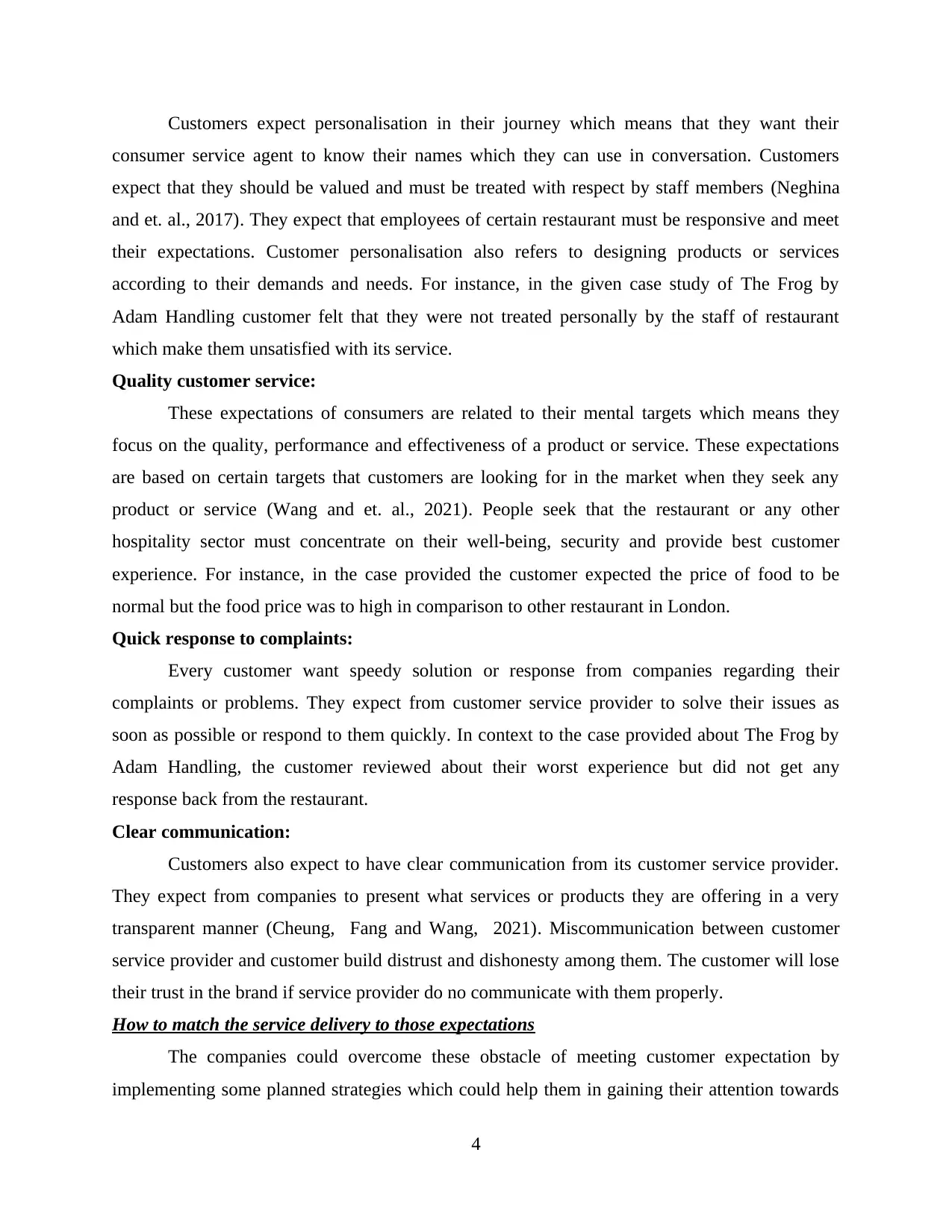
Customers expect personalisation in their journey which means that they want their
consumer service agent to know their names which they can use in conversation. Customers
expect that they should be valued and must be treated with respect by staff members (Neghina
and et. al., 2017). They expect that employees of certain restaurant must be responsive and meet
their expectations. Customer personalisation also refers to designing products or services
according to their demands and needs. For instance, in the given case study of The Frog by
Adam Handling customer felt that they were not treated personally by the staff of restaurant
which make them unsatisfied with its service.
Quality customer service:
These expectations of consumers are related to their mental targets which means they
focus on the quality, performance and effectiveness of a product or service. These expectations
are based on certain targets that customers are looking for in the market when they seek any
product or service (Wang and et. al., 2021). People seek that the restaurant or any other
hospitality sector must concentrate on their well-being, security and provide best customer
experience. For instance, in the case provided the customer expected the price of food to be
normal but the food price was to high in comparison to other restaurant in London.
Quick response to complaints:
Every customer want speedy solution or response from companies regarding their
complaints or problems. They expect from customer service provider to solve their issues as
soon as possible or respond to them quickly. In context to the case provided about The Frog by
Adam Handling, the customer reviewed about their worst experience but did not get any
response back from the restaurant.
Clear communication:
Customers also expect to have clear communication from its customer service provider.
They expect from companies to present what services or products they are offering in a very
transparent manner (Cheung, Fang and Wang, 2021). Miscommunication between customer
service provider and customer build distrust and dishonesty among them. The customer will lose
their trust in the brand if service provider do no communicate with them properly.
How to match the service delivery to those expectations
The companies could overcome these obstacle of meeting customer expectation by
implementing some planned strategies which could help them in gaining their attention towards
4
consumer service agent to know their names which they can use in conversation. Customers
expect that they should be valued and must be treated with respect by staff members (Neghina
and et. al., 2017). They expect that employees of certain restaurant must be responsive and meet
their expectations. Customer personalisation also refers to designing products or services
according to their demands and needs. For instance, in the given case study of The Frog by
Adam Handling customer felt that they were not treated personally by the staff of restaurant
which make them unsatisfied with its service.
Quality customer service:
These expectations of consumers are related to their mental targets which means they
focus on the quality, performance and effectiveness of a product or service. These expectations
are based on certain targets that customers are looking for in the market when they seek any
product or service (Wang and et. al., 2021). People seek that the restaurant or any other
hospitality sector must concentrate on their well-being, security and provide best customer
experience. For instance, in the case provided the customer expected the price of food to be
normal but the food price was to high in comparison to other restaurant in London.
Quick response to complaints:
Every customer want speedy solution or response from companies regarding their
complaints or problems. They expect from customer service provider to solve their issues as
soon as possible or respond to them quickly. In context to the case provided about The Frog by
Adam Handling, the customer reviewed about their worst experience but did not get any
response back from the restaurant.
Clear communication:
Customers also expect to have clear communication from its customer service provider.
They expect from companies to present what services or products they are offering in a very
transparent manner (Cheung, Fang and Wang, 2021). Miscommunication between customer
service provider and customer build distrust and dishonesty among them. The customer will lose
their trust in the brand if service provider do no communicate with them properly.
How to match the service delivery to those expectations
The companies could overcome these obstacle of meeting customer expectation by
implementing some planned strategies which could help them in gaining their attention towards
4
⊘ This is a preview!⊘
Do you want full access?
Subscribe today to unlock all pages.

Trusted by 1+ million students worldwide
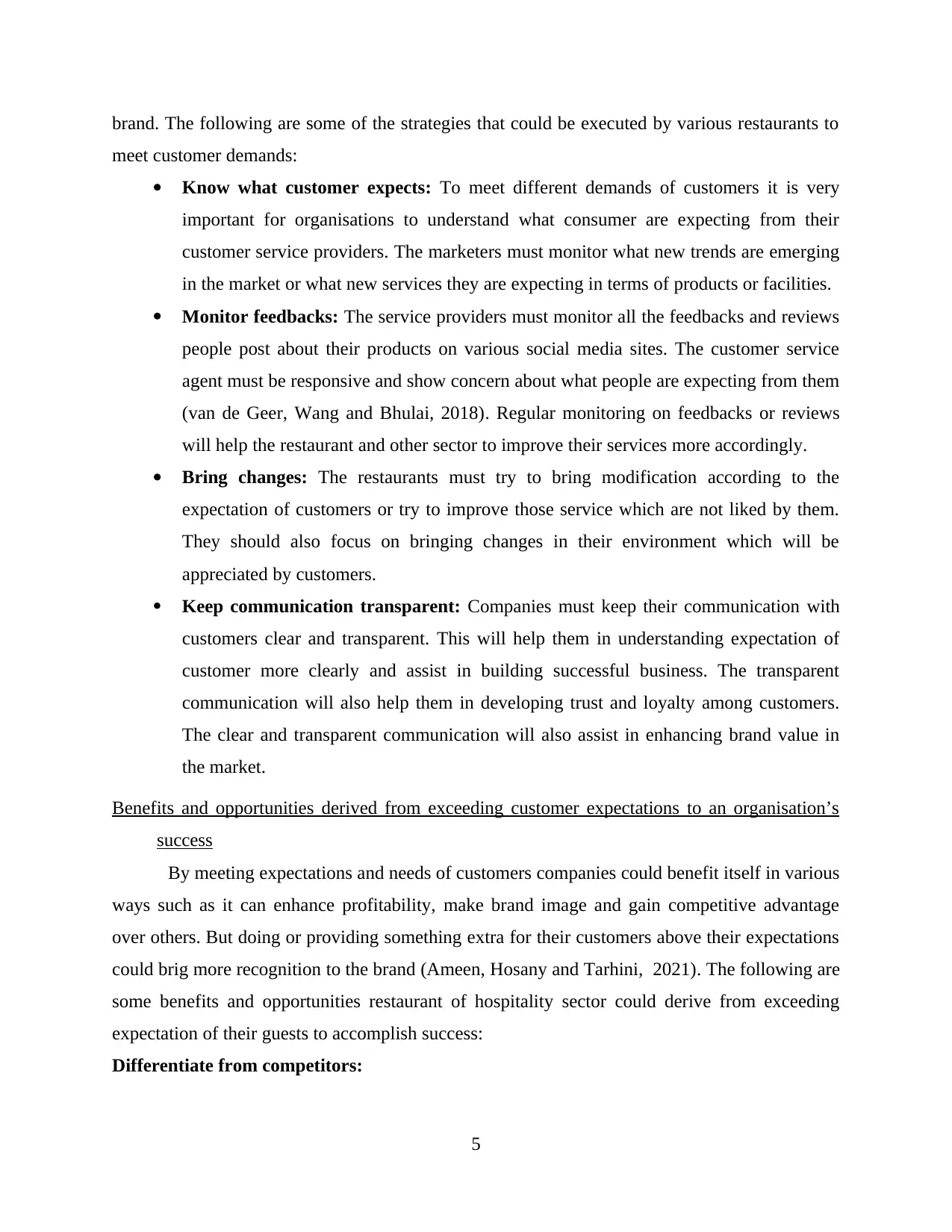
brand. The following are some of the strategies that could be executed by various restaurants to
meet customer demands:
Know what customer expects: To meet different demands of customers it is very
important for organisations to understand what consumer are expecting from their
customer service providers. The marketers must monitor what new trends are emerging
in the market or what new services they are expecting in terms of products or facilities.
Monitor feedbacks: The service providers must monitor all the feedbacks and reviews
people post about their products on various social media sites. The customer service
agent must be responsive and show concern about what people are expecting from them
(van de Geer, Wang and Bhulai, 2018). Regular monitoring on feedbacks or reviews
will help the restaurant and other sector to improve their services more accordingly.
Bring changes: The restaurants must try to bring modification according to the
expectation of customers or try to improve those service which are not liked by them.
They should also focus on bringing changes in their environment which will be
appreciated by customers.
Keep communication transparent: Companies must keep their communication with
customers clear and transparent. This will help them in understanding expectation of
customer more clearly and assist in building successful business. The transparent
communication will also help them in developing trust and loyalty among customers.
The clear and transparent communication will also assist in enhancing brand value in
the market.
Benefits and opportunities derived from exceeding customer expectations to an organisation’s
success
By meeting expectations and needs of customers companies could benefit itself in various
ways such as it can enhance profitability, make brand image and gain competitive advantage
over others. But doing or providing something extra for their customers above their expectations
could brig more recognition to the brand (Ameen, Hosany and Tarhini, 2021). The following are
some benefits and opportunities restaurant of hospitality sector could derive from exceeding
expectation of their guests to accomplish success:
Differentiate from competitors:
5
meet customer demands:
Know what customer expects: To meet different demands of customers it is very
important for organisations to understand what consumer are expecting from their
customer service providers. The marketers must monitor what new trends are emerging
in the market or what new services they are expecting in terms of products or facilities.
Monitor feedbacks: The service providers must monitor all the feedbacks and reviews
people post about their products on various social media sites. The customer service
agent must be responsive and show concern about what people are expecting from them
(van de Geer, Wang and Bhulai, 2018). Regular monitoring on feedbacks or reviews
will help the restaurant and other sector to improve their services more accordingly.
Bring changes: The restaurants must try to bring modification according to the
expectation of customers or try to improve those service which are not liked by them.
They should also focus on bringing changes in their environment which will be
appreciated by customers.
Keep communication transparent: Companies must keep their communication with
customers clear and transparent. This will help them in understanding expectation of
customer more clearly and assist in building successful business. The transparent
communication will also help them in developing trust and loyalty among customers.
The clear and transparent communication will also assist in enhancing brand value in
the market.
Benefits and opportunities derived from exceeding customer expectations to an organisation’s
success
By meeting expectations and needs of customers companies could benefit itself in various
ways such as it can enhance profitability, make brand image and gain competitive advantage
over others. But doing or providing something extra for their customers above their expectations
could brig more recognition to the brand (Ameen, Hosany and Tarhini, 2021). The following are
some benefits and opportunities restaurant of hospitality sector could derive from exceeding
expectation of their guests to accomplish success:
Differentiate from competitors:
5
Paraphrase This Document
Need a fresh take? Get an instant paraphrase of this document with our AI Paraphraser
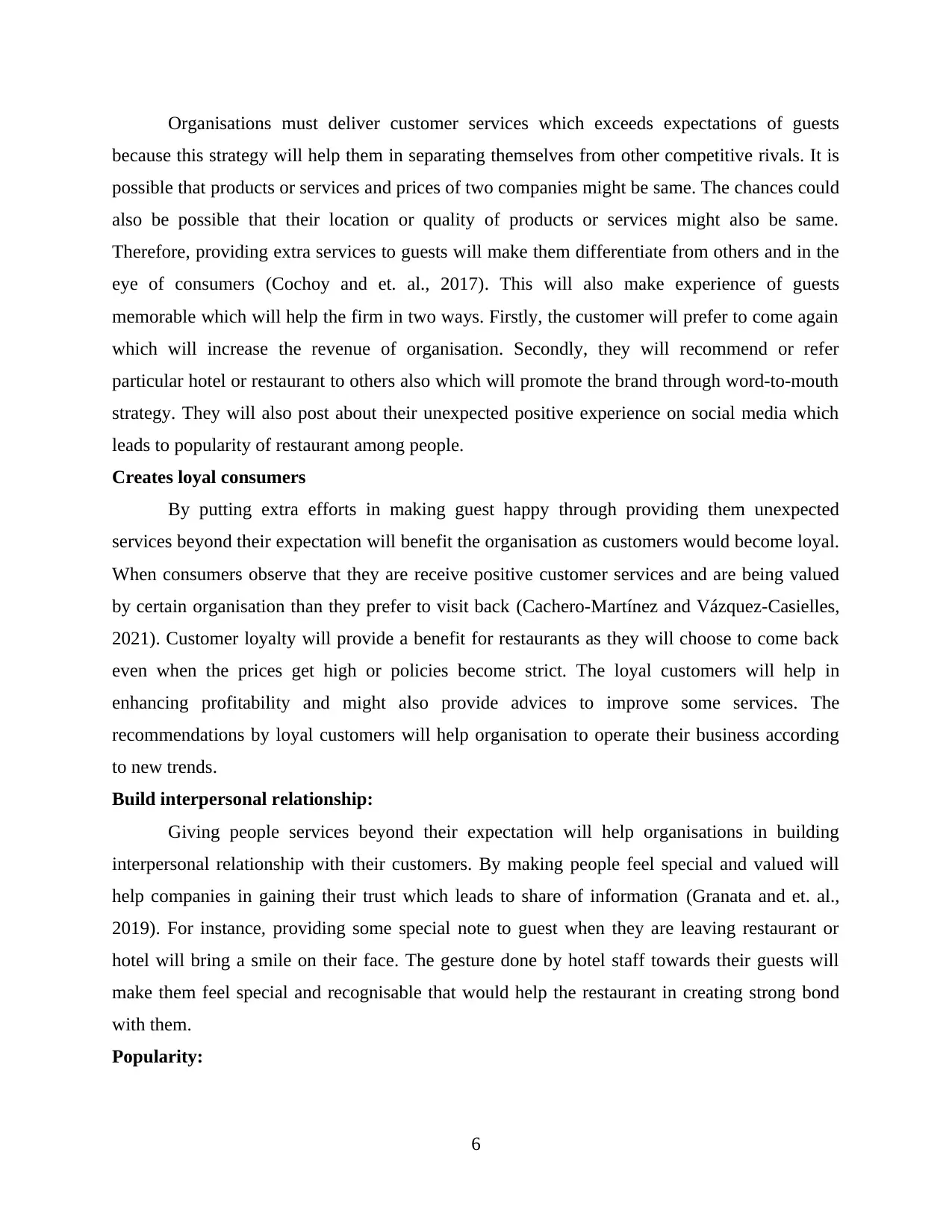
Organisations must deliver customer services which exceeds expectations of guests
because this strategy will help them in separating themselves from other competitive rivals. It is
possible that products or services and prices of two companies might be same. The chances could
also be possible that their location or quality of products or services might also be same.
Therefore, providing extra services to guests will make them differentiate from others and in the
eye of consumers (Cochoy and et. al., 2017). This will also make experience of guests
memorable which will help the firm in two ways. Firstly, the customer will prefer to come again
which will increase the revenue of organisation. Secondly, they will recommend or refer
particular hotel or restaurant to others also which will promote the brand through word-to-mouth
strategy. They will also post about their unexpected positive experience on social media which
leads to popularity of restaurant among people.
Creates loyal consumers
By putting extra efforts in making guest happy through providing them unexpected
services beyond their expectation will benefit the organisation as customers would become loyal.
When consumers observe that they are receive positive customer services and are being valued
by certain organisation than they prefer to visit back (Cachero-Martínez and Vázquez-Casielles,
2021). Customer loyalty will provide a benefit for restaurants as they will choose to come back
even when the prices get high or policies become strict. The loyal customers will help in
enhancing profitability and might also provide advices to improve some services. The
recommendations by loyal customers will help organisation to operate their business according
to new trends.
Build interpersonal relationship:
Giving people services beyond their expectation will help organisations in building
interpersonal relationship with their customers. By making people feel special and valued will
help companies in gaining their trust which leads to share of information (Granata and et. al.,
2019). For instance, providing some special note to guest when they are leaving restaurant or
hotel will bring a smile on their face. The gesture done by hotel staff towards their guests will
make them feel special and recognisable that would help the restaurant in creating strong bond
with them.
Popularity:
6
because this strategy will help them in separating themselves from other competitive rivals. It is
possible that products or services and prices of two companies might be same. The chances could
also be possible that their location or quality of products or services might also be same.
Therefore, providing extra services to guests will make them differentiate from others and in the
eye of consumers (Cochoy and et. al., 2017). This will also make experience of guests
memorable which will help the firm in two ways. Firstly, the customer will prefer to come again
which will increase the revenue of organisation. Secondly, they will recommend or refer
particular hotel or restaurant to others also which will promote the brand through word-to-mouth
strategy. They will also post about their unexpected positive experience on social media which
leads to popularity of restaurant among people.
Creates loyal consumers
By putting extra efforts in making guest happy through providing them unexpected
services beyond their expectation will benefit the organisation as customers would become loyal.
When consumers observe that they are receive positive customer services and are being valued
by certain organisation than they prefer to visit back (Cachero-Martínez and Vázquez-Casielles,
2021). Customer loyalty will provide a benefit for restaurants as they will choose to come back
even when the prices get high or policies become strict. The loyal customers will help in
enhancing profitability and might also provide advices to improve some services. The
recommendations by loyal customers will help organisation to operate their business according
to new trends.
Build interpersonal relationship:
Giving people services beyond their expectation will help organisations in building
interpersonal relationship with their customers. By making people feel special and valued will
help companies in gaining their trust which leads to share of information (Granata and et. al.,
2019). For instance, providing some special note to guest when they are leaving restaurant or
hotel will bring a smile on their face. The gesture done by hotel staff towards their guests will
make them feel special and recognisable that would help the restaurant in creating strong bond
with them.
Popularity:
6
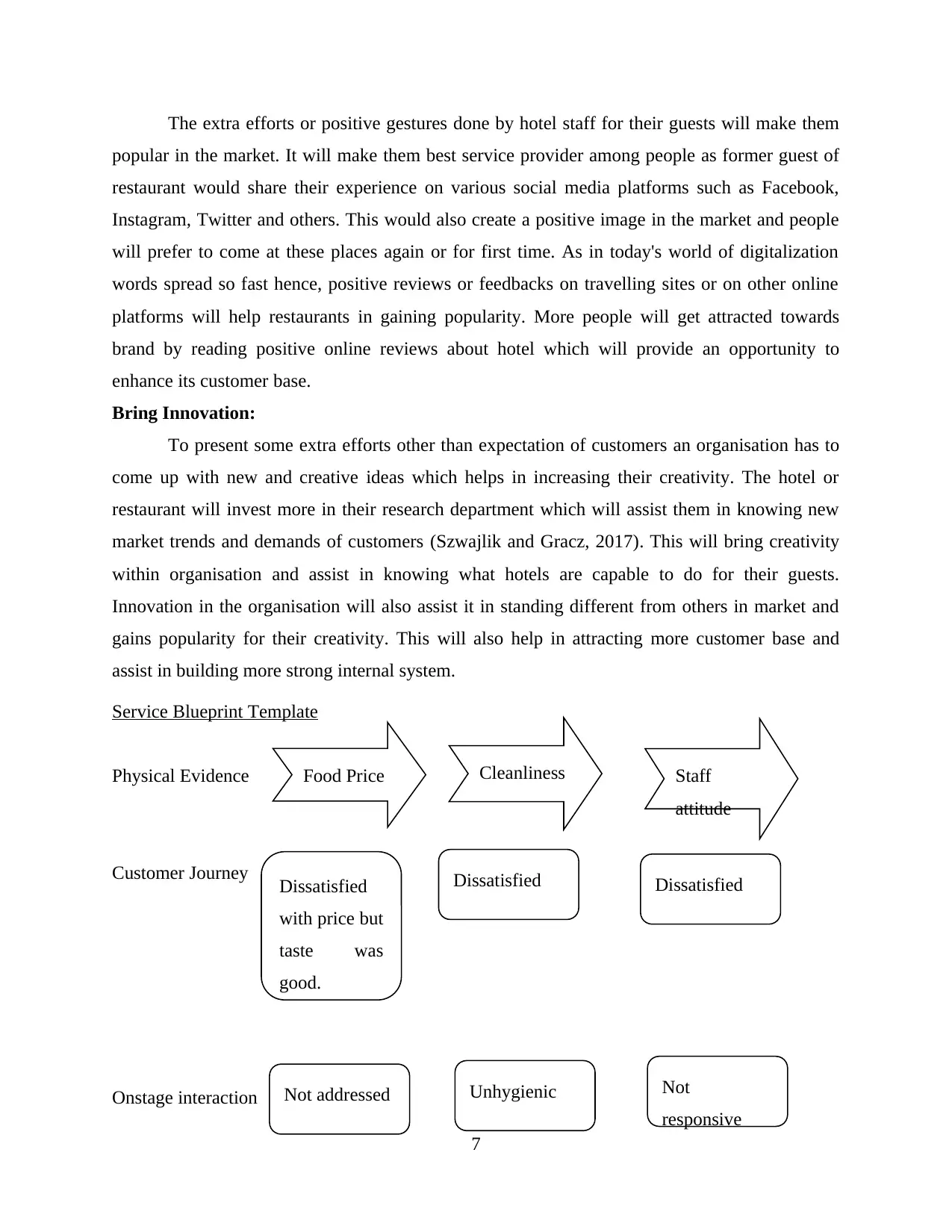
The extra efforts or positive gestures done by hotel staff for their guests will make them
popular in the market. It will make them best service provider among people as former guest of
restaurant would share their experience on various social media platforms such as Facebook,
Instagram, Twitter and others. This would also create a positive image in the market and people
will prefer to come at these places again or for first time. As in today's world of digitalization
words spread so fast hence, positive reviews or feedbacks on travelling sites or on other online
platforms will help restaurants in gaining popularity. More people will get attracted towards
brand by reading positive online reviews about hotel which will provide an opportunity to
enhance its customer base.
Bring Innovation:
To present some extra efforts other than expectation of customers an organisation has to
come up with new and creative ideas which helps in increasing their creativity. The hotel or
restaurant will invest more in their research department which will assist them in knowing new
market trends and demands of customers (Szwajlik and Gracz, 2017). This will bring creativity
within organisation and assist in knowing what hotels are capable to do for their guests.
Innovation in the organisation will also assist it in standing different from others in market and
gains popularity for their creativity. This will also help in attracting more customer base and
assist in building more strong internal system.
Service Blueprint Template
Physical Evidence
Customer Journey
Onstage interaction
7
Food Price Staff
attitude
Cleanliness
Dissatisfied
with price but
taste was
good.
DissatisfiedDissatisfied
Unhygienic Not
responsive
Not addressed
popular in the market. It will make them best service provider among people as former guest of
restaurant would share their experience on various social media platforms such as Facebook,
Instagram, Twitter and others. This would also create a positive image in the market and people
will prefer to come at these places again or for first time. As in today's world of digitalization
words spread so fast hence, positive reviews or feedbacks on travelling sites or on other online
platforms will help restaurants in gaining popularity. More people will get attracted towards
brand by reading positive online reviews about hotel which will provide an opportunity to
enhance its customer base.
Bring Innovation:
To present some extra efforts other than expectation of customers an organisation has to
come up with new and creative ideas which helps in increasing their creativity. The hotel or
restaurant will invest more in their research department which will assist them in knowing new
market trends and demands of customers (Szwajlik and Gracz, 2017). This will bring creativity
within organisation and assist in knowing what hotels are capable to do for their guests.
Innovation in the organisation will also assist it in standing different from others in market and
gains popularity for their creativity. This will also help in attracting more customer base and
assist in building more strong internal system.
Service Blueprint Template
Physical Evidence
Customer Journey
Onstage interaction
7
Food Price Staff
attitude
Cleanliness
Dissatisfied
with price but
taste was
good.
DissatisfiedDissatisfied
Unhygienic Not
responsive
Not addressed
⊘ This is a preview!⊘
Do you want full access?
Subscribe today to unlock all pages.

Trusted by 1+ million students worldwide
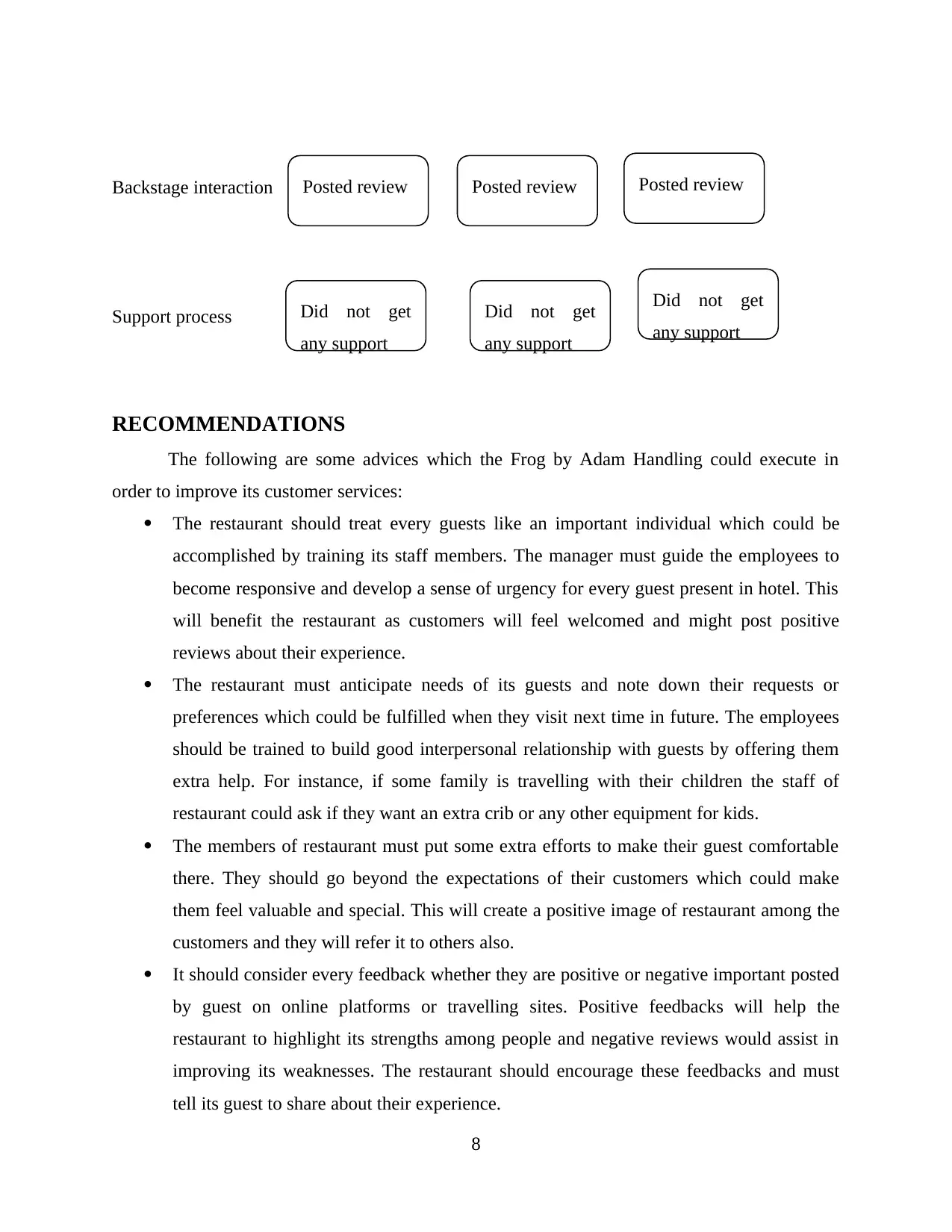
Backstage interaction
Support process
RECOMMENDATIONS
The following are some advices which the Frog by Adam Handling could execute in
order to improve its customer services:
The restaurant should treat every guests like an important individual which could be
accomplished by training its staff members. The manager must guide the employees to
become responsive and develop a sense of urgency for every guest present in hotel. This
will benefit the restaurant as customers will feel welcomed and might post positive
reviews about their experience.
The restaurant must anticipate needs of its guests and note down their requests or
preferences which could be fulfilled when they visit next time in future. The employees
should be trained to build good interpersonal relationship with guests by offering them
extra help. For instance, if some family is travelling with their children the staff of
restaurant could ask if they want an extra crib or any other equipment for kids.
The members of restaurant must put some extra efforts to make their guest comfortable
there. They should go beyond the expectations of their customers which could make
them feel valuable and special. This will create a positive image of restaurant among the
customers and they will refer it to others also.
It should consider every feedback whether they are positive or negative important posted
by guest on online platforms or travelling sites. Positive feedbacks will help the
restaurant to highlight its strengths among people and negative reviews would assist in
improving its weaknesses. The restaurant should encourage these feedbacks and must
tell its guest to share about their experience.
8
Did not get
any support
Posted review Posted reviewPosted review
Did not get
any support
Did not get
any support
Support process
RECOMMENDATIONS
The following are some advices which the Frog by Adam Handling could execute in
order to improve its customer services:
The restaurant should treat every guests like an important individual which could be
accomplished by training its staff members. The manager must guide the employees to
become responsive and develop a sense of urgency for every guest present in hotel. This
will benefit the restaurant as customers will feel welcomed and might post positive
reviews about their experience.
The restaurant must anticipate needs of its guests and note down their requests or
preferences which could be fulfilled when they visit next time in future. The employees
should be trained to build good interpersonal relationship with guests by offering them
extra help. For instance, if some family is travelling with their children the staff of
restaurant could ask if they want an extra crib or any other equipment for kids.
The members of restaurant must put some extra efforts to make their guest comfortable
there. They should go beyond the expectations of their customers which could make
them feel valuable and special. This will create a positive image of restaurant among the
customers and they will refer it to others also.
It should consider every feedback whether they are positive or negative important posted
by guest on online platforms or travelling sites. Positive feedbacks will help the
restaurant to highlight its strengths among people and negative reviews would assist in
improving its weaknesses. The restaurant should encourage these feedbacks and must
tell its guest to share about their experience.
8
Did not get
any support
Posted review Posted reviewPosted review
Did not get
any support
Did not get
any support
Paraphrase This Document
Need a fresh take? Get an instant paraphrase of this document with our AI Paraphraser

The restaurant should also treat its employees with respect and dignity as it said that an
happy employee leads to happy clients. If the staff members will feel safe and happy in
the campus than they would put their efforts in treating guests nicely. The organisation
can organise group fun activities for them, reward them on their performance and
various other actions could be taken which will encourage them to perform with
dedication.
The organisation must reward or introduce some loyalty programmes for their repeated
customers in order to make them feel special. Loyalty programmes will help the
restaurant in attracting more customers and improve their services. This will make
people feel valued and recognized which further results to retention, profits and referrals.
CONCLUSION
From the above discussion it has been evaluated that customer service management play
an important role in making brand name recognizable in the market. For restaurant, hotel or any
other sector of hospitality industry it is very crucial to satisfy customer demands. It has also been
observed that there are various factors which could limit the customer services that must be
overcome by organisations. The firms must also meet the demands of customers by
understanding their behaviour and try to deliver services according to their expectation. It has
also been examined that organisations could offer extra benefits to their guest which would help
them in enhancing their profitability. The companies must also focus on bringing new innovation
strategies according to market trends which could benefit them in meeting expectation of their
targeted customers. In the end, it could be said that it is very vital to provide best customer
services for any hospitality sector.
9
happy employee leads to happy clients. If the staff members will feel safe and happy in
the campus than they would put their efforts in treating guests nicely. The organisation
can organise group fun activities for them, reward them on their performance and
various other actions could be taken which will encourage them to perform with
dedication.
The organisation must reward or introduce some loyalty programmes for their repeated
customers in order to make them feel special. Loyalty programmes will help the
restaurant in attracting more customers and improve their services. This will make
people feel valued and recognized which further results to retention, profits and referrals.
CONCLUSION
From the above discussion it has been evaluated that customer service management play
an important role in making brand name recognizable in the market. For restaurant, hotel or any
other sector of hospitality industry it is very crucial to satisfy customer demands. It has also been
observed that there are various factors which could limit the customer services that must be
overcome by organisations. The firms must also meet the demands of customers by
understanding their behaviour and try to deliver services according to their expectation. It has
also been examined that organisations could offer extra benefits to their guest which would help
them in enhancing their profitability. The companies must also focus on bringing new innovation
strategies according to market trends which could benefit them in meeting expectation of their
targeted customers. In the end, it could be said that it is very vital to provide best customer
services for any hospitality sector.
9
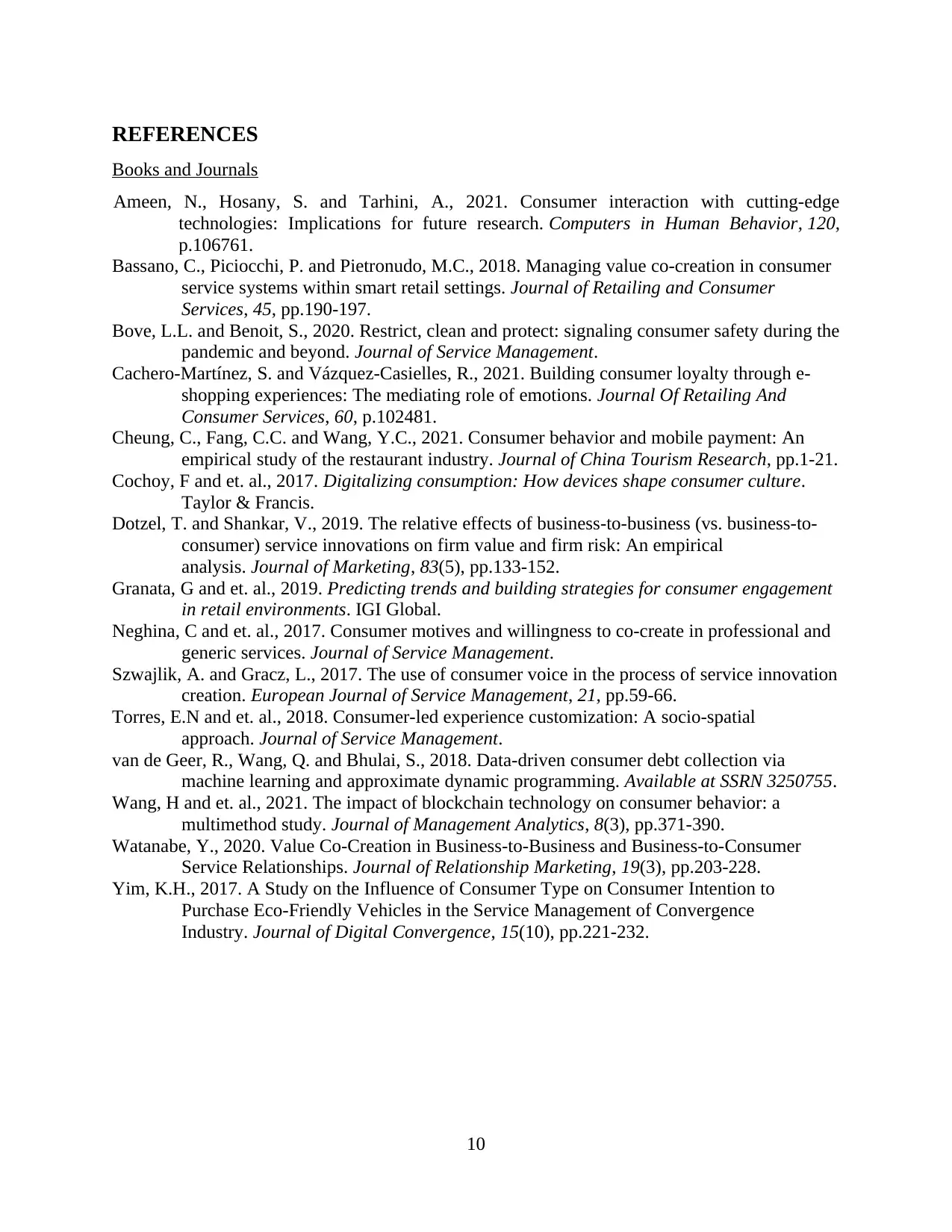
REFERENCES
Books and Journals
Ameen, N., Hosany, S. and Tarhini, A., 2021. Consumer interaction with cutting-edge
technologies: Implications for future research. Computers in Human Behavior, 120,
p.106761.
Bassano, C., Piciocchi, P. and Pietronudo, M.C., 2018. Managing value co-creation in consumer
service systems within smart retail settings. Journal of Retailing and Consumer
Services, 45, pp.190-197.
Bove, L.L. and Benoit, S., 2020. Restrict, clean and protect: signaling consumer safety during the
pandemic and beyond. Journal of Service Management.
Cachero-Martínez, S. and Vázquez-Casielles, R., 2021. Building consumer loyalty through e-
shopping experiences: The mediating role of emotions. Journal Of Retailing And
Consumer Services, 60, p.102481.
Cheung, C., Fang, C.C. and Wang, Y.C., 2021. Consumer behavior and mobile payment: An
empirical study of the restaurant industry. Journal of China Tourism Research, pp.1-21.
Cochoy, F and et. al., 2017. Digitalizing consumption: How devices shape consumer culture.
Taylor & Francis.
Dotzel, T. and Shankar, V., 2019. The relative effects of business-to-business (vs. business-to-
consumer) service innovations on firm value and firm risk: An empirical
analysis. Journal of Marketing, 83(5), pp.133-152.
Granata, G and et. al., 2019. Predicting trends and building strategies for consumer engagement
in retail environments. IGI Global.
Neghina, C and et. al., 2017. Consumer motives and willingness to co-create in professional and
generic services. Journal of Service Management.
Szwajlik, A. and Gracz, L., 2017. The use of consumer voice in the process of service innovation
creation. European Journal of Service Management, 21, pp.59-66.
Torres, E.N and et. al., 2018. Consumer-led experience customization: A socio-spatial
approach. Journal of Service Management.
van de Geer, R., Wang, Q. and Bhulai, S., 2018. Data-driven consumer debt collection via
machine learning and approximate dynamic programming. Available at SSRN 3250755.
Wang, H and et. al., 2021. The impact of blockchain technology on consumer behavior: a
multimethod study. Journal of Management Analytics, 8(3), pp.371-390.
Watanabe, Y., 2020. Value Co-Creation in Business-to-Business and Business-to-Consumer
Service Relationships. Journal of Relationship Marketing, 19(3), pp.203-228.
Yim, K.H., 2017. A Study on the Influence of Consumer Type on Consumer Intention to
Purchase Eco-Friendly Vehicles in the Service Management of Convergence
Industry. Journal of Digital Convergence, 15(10), pp.221-232.
10
Books and Journals
Ameen, N., Hosany, S. and Tarhini, A., 2021. Consumer interaction with cutting-edge
technologies: Implications for future research. Computers in Human Behavior, 120,
p.106761.
Bassano, C., Piciocchi, P. and Pietronudo, M.C., 2018. Managing value co-creation in consumer
service systems within smart retail settings. Journal of Retailing and Consumer
Services, 45, pp.190-197.
Bove, L.L. and Benoit, S., 2020. Restrict, clean and protect: signaling consumer safety during the
pandemic and beyond. Journal of Service Management.
Cachero-Martínez, S. and Vázquez-Casielles, R., 2021. Building consumer loyalty through e-
shopping experiences: The mediating role of emotions. Journal Of Retailing And
Consumer Services, 60, p.102481.
Cheung, C., Fang, C.C. and Wang, Y.C., 2021. Consumer behavior and mobile payment: An
empirical study of the restaurant industry. Journal of China Tourism Research, pp.1-21.
Cochoy, F and et. al., 2017. Digitalizing consumption: How devices shape consumer culture.
Taylor & Francis.
Dotzel, T. and Shankar, V., 2019. The relative effects of business-to-business (vs. business-to-
consumer) service innovations on firm value and firm risk: An empirical
analysis. Journal of Marketing, 83(5), pp.133-152.
Granata, G and et. al., 2019. Predicting trends and building strategies for consumer engagement
in retail environments. IGI Global.
Neghina, C and et. al., 2017. Consumer motives and willingness to co-create in professional and
generic services. Journal of Service Management.
Szwajlik, A. and Gracz, L., 2017. The use of consumer voice in the process of service innovation
creation. European Journal of Service Management, 21, pp.59-66.
Torres, E.N and et. al., 2018. Consumer-led experience customization: A socio-spatial
approach. Journal of Service Management.
van de Geer, R., Wang, Q. and Bhulai, S., 2018. Data-driven consumer debt collection via
machine learning and approximate dynamic programming. Available at SSRN 3250755.
Wang, H and et. al., 2021. The impact of blockchain technology on consumer behavior: a
multimethod study. Journal of Management Analytics, 8(3), pp.371-390.
Watanabe, Y., 2020. Value Co-Creation in Business-to-Business and Business-to-Consumer
Service Relationships. Journal of Relationship Marketing, 19(3), pp.203-228.
Yim, K.H., 2017. A Study on the Influence of Consumer Type on Consumer Intention to
Purchase Eco-Friendly Vehicles in the Service Management of Convergence
Industry. Journal of Digital Convergence, 15(10), pp.221-232.
10
⊘ This is a preview!⊘
Do you want full access?
Subscribe today to unlock all pages.

Trusted by 1+ million students worldwide
1 out of 12
Related Documents
Your All-in-One AI-Powered Toolkit for Academic Success.
+13062052269
info@desklib.com
Available 24*7 on WhatsApp / Email
![[object Object]](/_next/static/media/star-bottom.7253800d.svg)
Unlock your academic potential
Copyright © 2020–2025 A2Z Services. All Rights Reserved. Developed and managed by ZUCOL.





